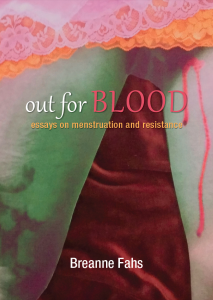Excerpt from Out for Blood: Essays on Menstruation and Resistance, by Breanne Fahs
SUNY Press, November, 2016
 In 2012 Petra Collins, an outspoken artist and activist, designed a t-shirt for American Apparel that depicted a hairy menstruating vulva with fingers spreading open the labia. As a piece of agitprop, this shirt successfully provoked a firestorm of angry responses. Deemed “outrageous,” “obscene,” and “disgusting,” with one news source calling it the “ultimate overshare,” the shirt never reached the shelves but nevertheless stirred up a frenzied social media battle about gendered double standards of obscenity (Collins 2013). In 2015 artist Rupi Kaur posted several menstrual-themed photos on her Instagram account in an effort to demystify menstruation. These photos included one of her laying fully-clothed with menstrual stains on her pants and sheets and another that showed her feet covered in dripping menstrual blood while she stood in the shower. Citing violations of community standards, Instagram twice removed the photographs and deemed them obscene (Saul 2015). Clearly, menstruation is not yet ready to come out of the menstrual closet, even in a culture that has supposedly dramatically improved gender inequities since the sexual revolution and women’s movement of the 1970s.
In 2012 Petra Collins, an outspoken artist and activist, designed a t-shirt for American Apparel that depicted a hairy menstruating vulva with fingers spreading open the labia. As a piece of agitprop, this shirt successfully provoked a firestorm of angry responses. Deemed “outrageous,” “obscene,” and “disgusting,” with one news source calling it the “ultimate overshare,” the shirt never reached the shelves but nevertheless stirred up a frenzied social media battle about gendered double standards of obscenity (Collins 2013). In 2015 artist Rupi Kaur posted several menstrual-themed photos on her Instagram account in an effort to demystify menstruation. These photos included one of her laying fully-clothed with menstrual stains on her pants and sheets and another that showed her feet covered in dripping menstrual blood while she stood in the shower. Citing violations of community standards, Instagram twice removed the photographs and deemed them obscene (Saul 2015). Clearly, menstruation is not yet ready to come out of the menstrual closet, even in a culture that has supposedly dramatically improved gender inequities since the sexual revolution and women’s movement of the 1970s.
Across the Pacific on the island of Komodo in Indonesia, menstruation conversations happen all the time and in the most public way imaginable, mostly to help women avoid being bitten by Komodo dragons. Because the dragons can smell blood (including menstrual blood) with remarkable accuracy and from great distances away—causing them to aggressively pursue their targets—women who enter Komodo island must sign waivers that attest to the fact that they are not currently menstruating; otherwise, government officials block them from entering the island altogether. These seemingly disparate anecdotes are but two of the many topics and stories about the contemporary culture of menstruation that Out for Blood examines.
Readers may ask, “Is there a culture of menstruation? A discourse of menstruation? Why does menstruation matter at all?” These questions form the basis of the necessary work that menstrual activists and scholars have taken up for many years. Half of the world’s population menstruates for large periods of their lives and yet surprisingly little scholarship has addressed the social meanings around this experience, let alone its potential as a site of gendered resistance. While a small (and fierce) group of feminist social scientists has studied menstruation for decades, too often their contributions have ended up sidelined by mainstream psychology and sociology. Dismissed either as something secretive, hidden, and taboo (and therefore too threatening to openly discuss and analyze), or disregarded as trivial and “silly” (and therefore not worthy of serious attention), the culture around, and discourses about, menstruation remain largely undertheorized and underexamined. When I talk openly about writing a book about menstruation and menstrual activism, I often hear (after some expressions of discomfort and amusement) two responses: “What’s that?” and “Why?”
What is Menstrual Activism?
Menstrual activism—or social activism that works to upset, challenge, and reverse impulses to silence and shame menstruating women—has many goals, tactics, and styles. It takes as its central premise the fusion between menstruation and anarchy (some call menstrual activism “menarchy”) and targets a wide range of social and political problems: the toxic substances in tampons and commercial menstrual products; increasing diagnoses of “premenstrual dysphoric disorder” (PMDD) and “premenstrual syndrome” (PMS); negative depictions of menstruating women in film, television, music, and popular culture; over-medicalization of menstrual cycles, including menstrual suppression; double standards in imagining women’s bodies as “dirty” and men’s bodies as “clean”; men’s attitudes about menstruation and menstrual products; early menstrual education and messages of shame and taboo embedded in such messages, and a variety of other problematic aspects of contemporary menstrual culture.
Menstrual activism is both formal (e.g., Blood Sisters) and informal (e.g., individual women making menstrual art); it offers coherent, organized critiques and tactical interventions (e.g., working to pass a congressional bill on tampon safety) and it draws from organic and informal modes of communication and connection (e.g., women sharing first period stories on Facebook). It offers showy and artistic public displays (e.g., Spanish performance artists walking along public streets wearing pants stained with menstrual blood) and more private and subtle shifts of thinking (e.g., women embracing menstrual sex). It draws from the culture of punk and anarchy alongside the do-it-yourself aesthetic that arose in the early 1990s, just as it puts into dialogue diverse and sometimes painful social questions about bodies and identities. Chris Bobel (2010), whose work on menstrual activism stands out as exceptional, wrote of the possibilities of menstrual activism, “Menstrual activism helps us see what’s at stake in the spirited debates about what to do about gender and the ongoing struggles to engage a truly racially, ethnically, and economically diverse movement of social change advocates around a common issue” (13). Menstrual activism offers multiple, diffuse, tactical, and intuitive forms of resistance, many of which this book considers in detail. It builds upon what we already know about the benefits of resistance, as those who rebel through activism on behalf of any issue have better physical health and more enjoyment of life (Rittenour and Colaner 2012), fewer eating disorders (Peterson, Grippo and Tantleff-Dunn 2008), better mental health outcomes (Szymanski and Owens 2009), and more satisfying sex lives (Schick, Zucker and Bay-Cheng 2008). I argue that menstruation and resistance go hand in hand, that menstruating bodies are always already infused with the potential for activism, solidarity, defiance, feminism, and rebellion.
Why Does Menstruation Matter?
With regard to why study menstrual activism and the culture of menstruation—in other words, why should we care?—my response typically gets more personal. While many people in the U.S. believe that sexism has almost disappeared in contemporary society (for a compelling critique of this rhetoric, see Swim and Cohen 1997), most researchers have identified uneven improvements in women’s lives (Acker 2006; Bettie 2003). Paula England (2010) argues that the last twenty years have seen many improvements in gender inequities in the workplace, but the practices of people in their homes and personal lives have resisted change in ways that directly (and negatively) impact women’s lives. Women’s bodies and sexualities, in particular, continue to face assaults in terms of safety, well-being, body image, and pleasure (Armstrong and Hamilton 2013; Fahs 2011a). In the midst of this, menstruation continues to exist as a silenced, disregarded, and at times abject or “disgusting” aspect of women’s daily lives. Negativity about menstruation subjects women to ridicule, dismissal, and trivialization (see Donald Trump’s recent attack on Fox News anchor Megyn Kelly after the first Presidential Debate of 2015 where he asserted that she asked him tough questions because she “had blood coming out of her eyes, blood coming out of her wherever”).
I have long studied subjects that others have called trivial or foolish or unworthy of scholarly attention. Typically, these subjects include aspects of bodies—particularly women’s bodies, bodies of color, and LGBT bodies—that connect to themes of agency/autonomy, social justice, and discourses of social control. For example, I have studied, written about, and taught about body hair for many years and have argued that hair is far from a trivial matter; rather, it symbolizes much about people’s relationship to identity, beauty, power, gender, race, class, and notions of “choice” (Fahs 2011b; Fahs 2012; Fahs 2013; Fahs 2014). Similarly, menstruation, another subject too often labeled as trivial, also reflects much about our culture’s relationship to women and their bodies, disgust, abjection, ideas about power and control, and gendered double standards (Fahs 2011c). The body is, I believe, an especially productive site of knowledge, and as such, serves as a serious point of contention and analysis for those who want to understand the exercise of, and deployment of, power.
Breanne Fahs is an Associate Professor of women and gender studies at Arizona State University, where she specializes in studying women’s sexuality, critical embodiment studies, radical feminism, and political activism. She is also a clinical psychologist specializing in sexuality, couples work, and trauma recovery. Out for Blood: Essays on Menstruation and Resistance is available at Amazon.

